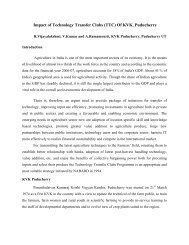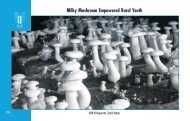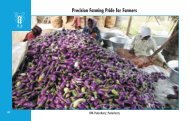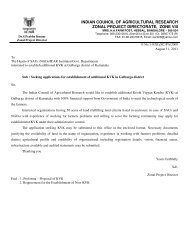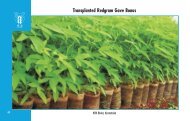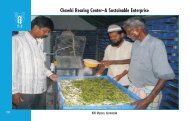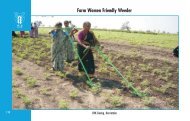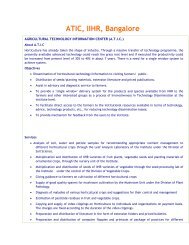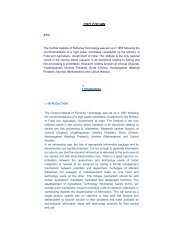Institutional linkage in promotion of organic farming in Karur district
Institutional linkage in promotion of organic farming in Karur district
Institutional linkage in promotion of organic farming in Karur district
You also want an ePaper? Increase the reach of your titles
YUMPU automatically turns print PDFs into web optimized ePapers that Google loves.
<strong>Institutional</strong> <strong>l<strong>in</strong>kage</strong> <strong>in</strong> <strong>promotion</strong> <strong>of</strong> <strong>organic</strong> farm<strong>in</strong>g <strong>in</strong> <strong>Karur</strong> <strong>district</strong><br />
S.Vallal Kannan, P.Ananda Priya and P.Tamilselvi, KVK <strong>Karur</strong> , Tamil Nadu<br />
Introduction<br />
The concept <strong>of</strong> <strong>organic</strong> farm<strong>in</strong>g is ga<strong>in</strong><strong>in</strong>g importance throughout the world for susta<strong>in</strong>able and eco<br />
friendly agricultural production. Look<strong>in</strong>g to the grow<strong>in</strong>g demand <strong>of</strong> <strong>organic</strong>ally produced products,<br />
many national and <strong>in</strong>ternational organizations have come forward for appropriate development and<br />
wider <strong>promotion</strong> <strong>of</strong> <strong>organic</strong> farm<strong>in</strong>g technologies. Indian <strong>organic</strong> producers and exporters are well<br />
aware <strong>of</strong> the demand for <strong>organic</strong> products, but the concept <strong>of</strong> <strong>organic</strong> farm<strong>in</strong>g is not yet clear <strong>in</strong> many<br />
concerns. The <strong>organic</strong> farm<strong>in</strong>g <strong>in</strong> real sense envisages an <strong>organic</strong> production system, based on specific<br />
standards precisely formulated for food production and aim at achiev<strong>in</strong>g agro ecosystems, which are<br />
socially and ecologically susta<strong>in</strong>able. In India, the total land under <strong>organic</strong> management is just 37050<br />
ha cover<strong>in</strong>g 5147 farm, which is just 0.03% <strong>of</strong> the geographical land (2005), this low percentage <strong>of</strong><br />
area, is due to lesser awareness among the Indian farmers. Even though India is hav<strong>in</strong>g vast potential<br />
for <strong>organic</strong> production and market<strong>in</strong>g at global level, its achievement on production, certification and<br />
export is low due to the lack <strong>of</strong> sufficient education on production with specific standards , lack <strong>of</strong> easy<br />
accessible <strong>in</strong>formation on <strong>organic</strong> methods, requirements and markets for <strong>in</strong>terested farmers, lack <strong>of</strong><br />
good consumer <strong>in</strong>formation on <strong>organic</strong> farm<strong>in</strong>g and <strong>organic</strong> food, high distribution costs, lack <strong>of</strong><br />
effective documentation and dissem<strong>in</strong>ation <strong>of</strong> research results among farmers and advisors, <strong>in</strong>sufficient<br />
practical orientation <strong>of</strong> research etc. In order to promote production <strong>of</strong> <strong>organic</strong> products with specific<br />
standards and provide support for their market<strong>in</strong>g, it is necessary to group the agencies cover<strong>in</strong>g<br />
Government Institutes, NGOs, Private entrepreneurs, Research Organizations, production /market<strong>in</strong>g<br />
units etc. the role <strong>of</strong> each agency should be identified for efficient dissem<strong>in</strong>ation <strong>of</strong> technologies.<br />
Intervention by KVK <strong>Karur</strong><br />
Internal Control System (ICS) is a documented quality assurance system that allows an external<br />
certification body to delegate the annual <strong>in</strong>spection <strong>of</strong> <strong>in</strong>dividual group members to an identified<br />
body/unit with<strong>in</strong> the certified operator. It means <strong>in</strong> practice that a growers group basically controls all<br />
farmers for compliance with <strong>organic</strong> production rules accord<strong>in</strong>g to def<strong>in</strong>ed procedures. The <strong>in</strong>ternal<br />
control system has been established by Krishi Vigyan Kendra, <strong>Karur</strong> Tamil Nadu, under the scheme <strong>of</strong><br />
National Project <strong>of</strong> Organic farm<strong>in</strong>g, Department <strong>of</strong> Agriculture and Cooperation (DAC), M<strong>in</strong>istry <strong>of</strong>
agriculture, New Delhi, to fulfil the <strong>organic</strong> group certification requirements <strong>of</strong> NPOP and EEC<br />
(2092/91) and to ensure <strong>organic</strong> standards on major crops production, handl<strong>in</strong>g and process<strong>in</strong>g. KVK<br />
<strong>Karur</strong> functioned as a technology messenger and played a significant role <strong>in</strong> group certification under<br />
Internal Control System by motivat<strong>in</strong>g farmers to form <strong>organic</strong> farmers groups and clusters, act<strong>in</strong>g as<br />
team leader <strong>of</strong> ICS and liaison with certification agencies, ma<strong>in</strong>ta<strong>in</strong><strong>in</strong>g records <strong>of</strong> <strong>organic</strong> farms,<br />
advices to the farmers on the package <strong>of</strong> practices, impart<strong>in</strong>g tra<strong>in</strong><strong>in</strong>g on preparation <strong>of</strong> on farm<br />
<strong>organic</strong> <strong>in</strong>puts and education <strong>of</strong> small and marg<strong>in</strong>al farmers about <strong>organic</strong> farm<strong>in</strong>g. The objectives <strong>of</strong><br />
group certification are to promote <strong>organic</strong> farm<strong>in</strong>g among the farmers, to <strong>in</strong>crease the productivity, to<br />
help small holders <strong>in</strong> group certification, to create avenues for export and to provide good quality food<br />
products to the consumers. The operational area was based on a cluster approach, <strong>in</strong> which the villages<br />
are grouped <strong>in</strong>to clusters based on close geographical proximity and uniformity <strong>in</strong> farm<strong>in</strong>g system,<br />
about 4 clusters were formed compris<strong>in</strong>g <strong>of</strong> C1-C4 cover<strong>in</strong>g 63 groups. Major crops grown <strong>in</strong> these<br />
clusters are paddy, sugarcane, banana, groundnut, and millets <strong>in</strong> agriculture and vegetables, tapioca<br />
and banana <strong>in</strong> horticulture. Under the ICS system, 1500 farmers are registered as <strong>organic</strong> farmers and<br />
tra<strong>in</strong>ed on the preparation <strong>of</strong> on farm <strong>organic</strong> <strong>in</strong>puts and educated about <strong>organic</strong> farm<strong>in</strong>g and provided<br />
advices on the packages <strong>of</strong> practices, documentation and l<strong>in</strong>ked with certification agencies and buyers<br />
for market<strong>in</strong>g.<br />
Follow<strong>in</strong>g are the problems faced by the <strong>organic</strong> growers <strong>of</strong> <strong>Karur</strong> District which were identified<br />
through Participatory Rural Appraisal techniques and focused group discussion.<br />
• Lack <strong>of</strong> <strong>in</strong>formation and knowledge on <strong>organic</strong> agriculture<br />
• Lesser productivity<br />
• Improper recycl<strong>in</strong>g <strong>of</strong> farm wastes<br />
• Less remunerative price<br />
• Less marketability<br />
• Poor documentation and<br />
• Poor quality ma<strong>in</strong>tenance <strong>of</strong> <strong>organic</strong> produce etc.<br />
KVK, <strong>Karur</strong> has fixed the strategies to overcome these problems as one <strong>of</strong> its thrust areas and<br />
l<strong>in</strong>ked various <strong>in</strong>stitutes on <strong>promotion</strong> <strong>of</strong> <strong>organic</strong> farm<strong>in</strong>g and market<strong>in</strong>g <strong>of</strong> <strong>organic</strong> produce as per the<br />
standards <strong>in</strong> <strong>Karur</strong> <strong>district</strong> and <strong>in</strong>tervened through various activities with follow<strong>in</strong>g objectives.
Objectives<br />
• To <strong>in</strong>crease the knowledge and skill on adoption <strong>of</strong> <strong>organic</strong> farm<strong>in</strong>g<br />
• To <strong>in</strong>crease area under <strong>organic</strong> and production <strong>of</strong> <strong>organic</strong> products<br />
• To generate <strong>in</strong>come and employment opportunities<br />
• To provide the support to access market <strong>in</strong>formation<br />
• To <strong>in</strong>crease the marketability <strong>of</strong> the <strong>organic</strong> produce<br />
Approaches<br />
KVK <strong>Karur</strong> has been promot<strong>in</strong>g the <strong>organic</strong> farm<strong>in</strong>g <strong>in</strong> the <strong>district</strong> through <strong>Institutional</strong><br />
approach (Fig. 1) by l<strong>in</strong>k<strong>in</strong>g SAUs and Research Stations for <strong>in</strong>formation on production aspects,<br />
NCOF for f<strong>in</strong>ancial support, APEDA for standards and quality control, Market<strong>in</strong>g <strong>in</strong>stitutions for<br />
market<strong>in</strong>g <strong>in</strong>formation and procurement and dissem<strong>in</strong>ation <strong>of</strong> technology and <strong>in</strong>formation through<br />
peoples <strong>in</strong>stitution (Master Tra<strong>in</strong>er) and group leaders <strong>in</strong> clusters (1-4). The KVK focused on l<strong>in</strong>k<strong>in</strong>g<br />
the various <strong>in</strong>stitutes for better <strong>organic</strong> farm<strong>in</strong>g, <strong>in</strong>crease <strong>in</strong> production and pr<strong>of</strong>itability.<br />
KVK <strong>in</strong>tervened through tra<strong>in</strong><strong>in</strong>gs and demonstrations for knowledge and skill up gradation.<br />
Exhibitions, mass media programmes and exposure visits were organized to create awareness as well<br />
as adoption <strong>of</strong> <strong>organic</strong> farm<strong>in</strong>g at larger scale.<br />
1. Tra<strong>in</strong><strong>in</strong>gs<br />
KVK has imparted the tra<strong>in</strong><strong>in</strong>g to farmers on <strong>organic</strong> farm<strong>in</strong>g with various topics like soil<br />
fertility management, pr<strong>in</strong>ciples and practices <strong>of</strong> <strong>organic</strong> farm<strong>in</strong>g, <strong>organic</strong> <strong>in</strong>put production<br />
technologies, use <strong>of</strong> natural resources and ITK, documentation <strong>in</strong> <strong>organic</strong> farm<strong>in</strong>g and certification,<br />
post harvest techniques etc., both at farmer’s field and <strong>in</strong> KVK campus. The details <strong>of</strong> total number <strong>of</strong><br />
tra<strong>in</strong><strong>in</strong>gs given by the KVK and number <strong>of</strong> beneficiaries over the years are given <strong>in</strong> the follow<strong>in</strong>g<br />
table.<br />
S. No Year No. <strong>of</strong> tra<strong>in</strong><strong>in</strong>gs No. <strong>of</strong> participants<br />
1 2006 31 697<br />
2 2007 42 1459<br />
3 2008 49 1246
Total 122 3402
INSTITUTIONAL APPROACH<br />
Technical<br />
Information<br />
F<strong>in</strong>ancial<br />
Support<br />
Standards &<br />
Quality<br />
Control<br />
Market<strong>in</strong>g<br />
Information<br />
SAU<br />
NCOF<br />
APEDA<br />
Market<strong>in</strong>g<br />
Institute<br />
KVK<br />
Peoples Institute<br />
(Master Tra<strong>in</strong>er)<br />
Cluster 1‐4<br />
Farmers<br />
Export<strong>in</strong>g<br />
Process<strong>in</strong>g<br />
Institute<br />
Organic<br />
Products<br />
T<br />
e<br />
c<br />
h<br />
n<br />
o<br />
l<br />
o<br />
g<br />
y<br />
D<br />
i<br />
s<br />
s<br />
e<br />
m<br />
i<br />
n<br />
a<br />
t<br />
i<br />
o<br />
n<br />
Procurement<br />
Market<strong>in</strong>g
Details on number <strong>of</strong> tra<strong>in</strong><strong>in</strong>gs and participants<br />
2. Demonstrations<br />
a. Demonstration on use <strong>of</strong> bio <strong>in</strong>puts<br />
With the f<strong>in</strong>ancial support <strong>of</strong> NCOF, Ghaziabad, three demonstrations were conducted <strong>in</strong><br />
paddy, bhendi and banana <strong>in</strong> the villages <strong>of</strong> Vadaseri, Archampatty and Muthalaipatty<br />
respectively on bio <strong>in</strong>puts. It had created confidence among the farmers on <strong>organic</strong> production<br />
technologies and other fellow farmers have accepted to adopt these technologies on trial basis <strong>in</strong><br />
m<strong>in</strong>imum area. The <strong>in</strong>puts namely bio-fertilizers and bio pesticides, (Azospirillum,<br />
Phosphobacteria, Pseudomonas & Trichoderma), bio control agents (Trichogramma japonicum,.<br />
Trichogramma Chilonis), green manures (Sunhemp, Da<strong>in</strong>cha, Calotropis, Avarai, Kol<strong>in</strong>ji) and<br />
animal based manures and growth promoters (Panchakavya, Amirthapani, Vermicompost,<br />
vermiwash, fish am<strong>in</strong>o acids, fruits extracts), traps, botanicals and various enriched manures<br />
were supplied to farmers.<br />
Sl. No Crops Area (<strong>in</strong> ac.) Name <strong>of</strong> the village<br />
1 Paddy 1 Vadaseri<br />
2 Banana 1 Archampatty
3 Bhendi 1 Muthalaipatty<br />
b. Demonstration on the use <strong>of</strong> enriched bio gas slurry<br />
Importance <strong>of</strong> enriched biogas slurry was demonstrated at five locations <strong>in</strong> the crops viz.,<br />
sesame, sunflower and groundnut. Biogas slurry was enriched with nitrogen fix<strong>in</strong>g and nutrient<br />
solubiliz<strong>in</strong>g bacteria and fungi and their technology and its usage were demonstrated <strong>in</strong> addition<br />
to the various <strong>organic</strong> <strong>in</strong>puts. Pulutheri, Seethapatti, Vadasery, Tharagampatti and R.T. Malai<br />
from Kulithalai and Kadavur blocks farmers were <strong>in</strong>volved <strong>in</strong> these demonstrations.<br />
S. Crops Area No. <strong>of</strong><br />
Name <strong>of</strong> the village<br />
No<br />
(ac.) Demonstrations<br />
1 Sunflower 1 2 Pulutheri, Vadaseri<br />
2 G<strong>in</strong>gelly 1 2 R.T. Malai,Seethapatti<br />
3 Groundnut 1 1 Palaviduthi<br />
3. Exhibitions<br />
21 exhibitions were organized at various locations dur<strong>in</strong>g 2006-2008 and nearly 20000<br />
farmers, farm women, rural youth and extension functionaries have participated. Through these<br />
exhibitions awareness on <strong>organic</strong> farm<strong>in</strong>g and its importance was created widely among the<br />
farm<strong>in</strong>g community <strong>of</strong> <strong>Karur</strong> and nearby <strong>district</strong>s and also developed excellent network among<br />
the <strong>organic</strong> growers and between <strong>organic</strong> growers and consumers <strong>of</strong> <strong>organic</strong> produce.<br />
Sl. No Year No. <strong>of</strong> Programmes Beneficiaries<br />
1 2006 3 904<br />
2 2007 13 11938<br />
3 2008 5 6984<br />
Total 21 19826<br />
Details on number <strong>of</strong> exhibitions organized and number <strong>of</strong> participants
4. Mass media programme<br />
Similarly, the services <strong>of</strong> mass media like TV, Radio and Newspaper were utilized for<br />
<strong>promotion</strong> <strong>of</strong> <strong>organic</strong> farm<strong>in</strong>g among the farmers.<br />
Programme<br />
Year<br />
2006 2007 2008<br />
TV 14 10 13<br />
Radio 20 48 34<br />
Newspaper coverage 15 32 47<br />
Mass media programme<br />
5. Publication
To create awareness and enrich the farmers’ knowledge on <strong>organic</strong> farm<strong>in</strong>g, the follow<strong>in</strong>g<br />
publication were developed and distributed to the farmers.<br />
Folders<br />
1. Direct seeded rice – Organic farm<strong>in</strong>g<br />
2. Organic rice cultivation techniques<br />
3. Organic bhendi cultivation<br />
4. Organic certification process<br />
5. Organic sunflower cultivation<br />
6. Importance <strong>of</strong> <strong>organic</strong> farm<strong>in</strong>g<br />
7. SKVK- Service provider<br />
Booklets<br />
1. Importance <strong>of</strong> vermi compost <strong>in</strong> <strong>organic</strong> farm<strong>in</strong>g<br />
2. Soil moisture conservation techniques and its importance<br />
3. Soil fertility management <strong>in</strong> <strong>organic</strong> farm<strong>in</strong>g<br />
4. Organic Input Production technologies<br />
Manual<br />
1. ICS manual – Organic farm<strong>in</strong>g (Tamil& English)<br />
2. Compendium on <strong>organic</strong> farm<strong>in</strong>g<br />
News letter<br />
For up gradation <strong>of</strong> knowledge on <strong>organic</strong> farm<strong>in</strong>g, recent trends <strong>in</strong> <strong>organic</strong> farm<strong>in</strong>g,<br />
marketability <strong>of</strong> the <strong>organic</strong> <strong>in</strong>puts and produce, activities undertaken and future activities<br />
planned by the KVK for the <strong>promotion</strong> <strong>of</strong> <strong>organic</strong> farm<strong>in</strong>g for three months period, KVK<br />
prepared quarterly newsletter entitled “Organic renaissance” and distributed to the <strong>organic</strong><br />
growers <strong>of</strong> the <strong>district</strong>.<br />
6. Exposure Visit<br />
Totally 14 numbers <strong>of</strong> exposure visits were arranged by the KVK from 2006 to 2008<br />
based on the concept <strong>of</strong> “See<strong>in</strong>g is believ<strong>in</strong>g”, <strong>in</strong> which totally 763 farmers.<br />
Sl. No Year No. <strong>of</strong> Programmes No. <strong>of</strong> participants<br />
1 2006 2 106
2 2007 5 240<br />
3 2008 7 417<br />
Total 14 763<br />
Details on exposure visit organized by KVK <strong>Karur</strong><br />
Impact assessment<br />
Methodology<br />
The study was conducted at the operational area <strong>of</strong> KVK <strong>Karur</strong>. The data about<br />
awareness, knowledge and adoption <strong>of</strong> <strong>organic</strong> farm<strong>in</strong>g technologies were collected through<br />
<strong>in</strong>terview schedule dur<strong>in</strong>g the year 2005 and 2008 with the same respondents <strong>in</strong> their farms and<br />
homes. The area <strong>in</strong>creased under <strong>organic</strong> cultivation, production and productivity and<br />
marketability were assessed from the data available <strong>in</strong> the ICS cluster <strong>of</strong>ficial documents and<br />
documents at farmers level.<br />
1. Awareness, Knowledge and Adoption level <strong>of</strong> farmers on Organic farm<strong>in</strong>g<br />
This study was conducted among the <strong>in</strong>dividuals who underwent the tra<strong>in</strong><strong>in</strong>g on <strong>organic</strong><br />
farm<strong>in</strong>g organized by the KVK. The respondents <strong>of</strong> 120 farmers were selected at random and the<br />
<strong>in</strong>formation revealed that majority <strong>of</strong> the respondents had high level <strong>of</strong> awareness about <strong>organic</strong><br />
farm<strong>in</strong>g techniques related on soil fertility management, land selection techniques for <strong>organic</strong><br />
farm<strong>in</strong>g, pest and disease management and post harvest technologies etc.,
Increase <strong>in</strong> awareness level <strong>of</strong> respondents on <strong>organic</strong> farm<strong>in</strong>g<br />
S.No. Awareness level No. <strong>of</strong> respondents<br />
% <strong>of</strong> respondents<br />
n=120<br />
2005 2008 2005 2008<br />
1 Low 18 4 15 3<br />
2 Medium 71 22 59 18<br />
3 High 31 95 26 79<br />
Awareness level <strong>of</strong> respondents dur<strong>in</strong>g 2005 was low (15 %), medium (59%) and high<br />
level (26%). But dur<strong>in</strong>g 2008, the majority <strong>of</strong> the respondents (79 %) had high level <strong>of</strong><br />
awareness. Only 3 % <strong>of</strong> farmers had low level <strong>of</strong> awareness. Awareness level <strong>of</strong> respondents on<br />
<strong>organic</strong> farm<strong>in</strong>g had <strong>in</strong>creased from 26 % to 79 % at high level, reduced from 59 % to 18 % and<br />
15 % to 4 % at medium level and low level respectively.<br />
Awareness about <strong>organic</strong> farm<strong>in</strong>g technologies<br />
Knowledge level <strong>of</strong> respondents <strong>in</strong> <strong>organic</strong> farm<strong>in</strong>g
n=120<br />
S.No.<br />
Knowledge level<br />
No. <strong>of</strong> respondents<br />
% <strong>of</strong> respondents<br />
2005 2008 2005 2008<br />
1 Low 10 1 9 1<br />
2 Medium 59 19 49 16<br />
3 High 50 100 42 83<br />
Dur<strong>in</strong>g 2005, 42 % <strong>of</strong> the respondents had high level <strong>of</strong> knowledge on <strong>organic</strong> farm<strong>in</strong>g<br />
related to soil fertility management, pest and disease control techniques. 49 % and 9 % <strong>of</strong><br />
respondents had medium and low level <strong>of</strong> knowledge particularly <strong>in</strong> land selection, <strong>in</strong>spection<br />
and certification process, certification agencies etc.<br />
But dur<strong>in</strong>g 2008, majority <strong>of</strong> the respondents (83%) had high level <strong>of</strong> knowledge on<br />
<strong>organic</strong> farm<strong>in</strong>g <strong>in</strong> all aspects like pr<strong>in</strong>ciples <strong>of</strong> <strong>organic</strong> farm<strong>in</strong>g, soil fertility improvement, land<br />
selection for <strong>organic</strong> farm<strong>in</strong>g, pest and disease management, post harvest technologies and<br />
documentation and certification process etc. Knowledge level <strong>of</strong> respondents had doubled from<br />
2005 (42 %) to 2008 (83%) at high level. The reason beh<strong>in</strong>d this was more number <strong>of</strong> tra<strong>in</strong><strong>in</strong>gs,<br />
demonstrations and extension activities organized by the KVK at regular <strong>in</strong>tervals.<br />
Knowledge level <strong>of</strong> respondents <strong>in</strong> <strong>organic</strong> farm<strong>in</strong>g
Number <strong>of</strong> <strong>organic</strong> growers group formed<br />
S. No Cluster 2006 2007 2008<br />
No. <strong>of</strong> No. <strong>of</strong> No. <strong>of</strong> No. <strong>of</strong> No. <strong>of</strong> No. <strong>of</strong><br />
groups <strong>organic</strong><br />
growers<br />
groups <strong>organic</strong><br />
growers<br />
groups <strong>organic</strong><br />
growers<br />
1 C1 20 360 34 612 10 193<br />
2 C2 2 58 3 86 6 121<br />
3 C3 3 93 8 236 4 79<br />
4 C4 2 21 2 37 2 34<br />
27 532 47 971 22 427<br />
Dur<strong>in</strong>g 2006, totally 532 <strong>organic</strong> growers were registered under 27 groups. However<br />
dur<strong>in</strong>g 2007, 971 <strong>organic</strong> growers registered as <strong>organic</strong> growers under 47 groups and dur<strong>in</strong>g<br />
2008 (upto September) there were 22 groups with 427 <strong>organic</strong> growers.<br />
Details on number <strong>of</strong> <strong>organic</strong> growers group formed<br />
Number <strong>of</strong> technocrats developed<br />
KVK <strong>Karur</strong> formed 96 <strong>organic</strong> growers group. In each group a leader was identified on<br />
consensus mode and they were tra<strong>in</strong>ed on <strong>organic</strong> farm<strong>in</strong>g <strong>in</strong> standards for <strong>organic</strong> cultivation,<br />
documentation and procedure for certification and market<strong>in</strong>g. By this way the group leaders<br />
became as technocrats and dissem<strong>in</strong>ated the technology and taken the responsibility <strong>of</strong><br />
documentation and ma<strong>in</strong>ta<strong>in</strong><strong>in</strong>g the standards. Through technocrats the technology spread was<br />
high because they are localite and hence their credibility was high. The details <strong>of</strong> number <strong>of</strong><br />
technocrats developed over the years are given below.
S.No.<br />
Cluster<br />
No. <strong>of</strong> technocrats<br />
2006 2007 2008<br />
1 C1 2 10 42<br />
2 C2 0 2 3<br />
3 C3 2 3 6<br />
4 C4 0 2 2<br />
Total 4 17 53<br />
Dur<strong>in</strong>g 2006, four <strong>organic</strong> growers were developed as technocrats through various master<br />
tra<strong>in</strong><strong>in</strong>gs on <strong>organic</strong> farm<strong>in</strong>g. Similarly dur<strong>in</strong>g 2007 and 2008, 17 and 53 technocrats were<br />
developed respectively.
Adoption level <strong>of</strong> respondents on <strong>organic</strong> farm<strong>in</strong>g techniques<br />
S. No Knowledge level<br />
No. <strong>of</strong> respondents<br />
% <strong>of</strong> respondents<br />
n=120<br />
2005 2008 2005 2008<br />
1 Low 64 1 53 1<br />
2 Medium 32 17 27 14<br />
3 High 24 102 20 85<br />
Dur<strong>in</strong>g 2005, farmers adopted <strong>organic</strong> farm<strong>in</strong>g <strong>in</strong> an unscientific way. Hence they<br />
realized low pr<strong>of</strong>it. Half <strong>of</strong> the respondents and nearly equal percentage <strong>of</strong> respondents adopted<br />
the <strong>organic</strong> farm<strong>in</strong>g techniques like soil fertility management pest and disease management, post<br />
harvest techniques etc at low, medium and high level respectively. But the documentation was<br />
nil. They did not take any measure to avoid contam<strong>in</strong>ation like buffer zone for prevention <strong>of</strong> drift<br />
and water contam<strong>in</strong>ation. Dur<strong>in</strong>g 2008, majority <strong>of</strong> the respondents (85%) adopt the <strong>organic</strong><br />
farm<strong>in</strong>g <strong>in</strong> scientific manner <strong>in</strong> all aspects from field selection to harvest and market<strong>in</strong>g but<br />
lack<strong>in</strong>g <strong>in</strong> documentation. Only few farmers came under medium level <strong>of</strong> adoption <strong>of</strong> <strong>organic</strong><br />
farm<strong>in</strong>g.<br />
Adoption level <strong>of</strong> respondents on <strong>organic</strong> farm<strong>in</strong>g techniques
2) Trend <strong>in</strong> area under <strong>organic</strong> farm<strong>in</strong>g and number <strong>of</strong> farmers adopt<strong>in</strong>g the<br />
technology<br />
Dur<strong>in</strong>g 2006, there were 532 farmers registered as <strong>organic</strong> growers and totally 116.82 ha<br />
were cultivated under <strong>organic</strong> crops like paddy, banana, sesame, sunflower, groundnut, green<br />
gram and black gram etc. Dur<strong>in</strong>g 2007 and 2008, 971 and 1398 farmers were registered and<br />
cultivated various crops under <strong>organic</strong> <strong>in</strong> 198 and 269.63 ha respectively.<br />
S.No. Cluster 2006 2007 2008<br />
Farmers<br />
(No.)<br />
Area<br />
(ha)<br />
Farmers<br />
(No.)<br />
Area<br />
(ha)<br />
Farmers<br />
(No.)<br />
Area<br />
(ha)<br />
1 C1 360 75.25 612 127.63 805 161.56<br />
2 C2 58 8.76 86 12.92 207 31.51<br />
3 C3 93 16.38 236 28.53 315 41.45<br />
4 C4 21 16.42 37 28.93 71 35.11<br />
Total 532 116.82 971 198.00 1398 269.63<br />
2.1. Organic area under certification<br />
The registered farmers have allotted specific area for <strong>organic</strong> farm<strong>in</strong>g dur<strong>in</strong>g and slowly<br />
implemented <strong>organic</strong> practices <strong>in</strong> the allotted fields through the support <strong>of</strong> the KVK through<br />
various approaches. F<strong>in</strong>ally the same were made available for certification. The results related to<br />
specific standards and the results <strong>of</strong> number <strong>of</strong> farmers and area are given <strong>in</strong> the follow<strong>in</strong>g table.
2.1. a .Organic area under certification (Conversion I)<br />
S. No Cluster 2006 2007 2008<br />
Farmers<br />
(No.)<br />
Area<br />
(ha)<br />
Farmers<br />
(No.)<br />
Area<br />
(ha)<br />
Farmers<br />
(No.)<br />
Area<br />
(ha)<br />
1 C1 - - 16 18.11 23 18.80<br />
2 C2 - - 1 1.41 10 2.57<br />
3 C3 - - - - 16 8.04<br />
4 C4 - - - - 6 1.94<br />
Total - - 17 19.52 55 31.34<br />
Dur<strong>in</strong>g 2007, both <strong>in</strong>ternal and external <strong>in</strong>spection was done by SKVK and Lacon quality<br />
certification India private Ltd., Kerala. Out <strong>of</strong> 779.5 ac.<strong>of</strong> area registered under <strong>organic</strong>, nearly<br />
50 ac were certified under conversion I. Inspection report is enclosed <strong>in</strong> Annexure II. Dur<strong>in</strong>g<br />
2008, <strong>organic</strong> fields were <strong>in</strong>spected and to be certified totally 77.61 ac under conversion status I.<br />
The major reasons for small area under certification found out dur<strong>in</strong>g <strong>in</strong>spection were small area<br />
allotment <strong>in</strong> paddy fields without buffer zone, staggered field selection, use <strong>of</strong> waste from sugar<br />
factory without compost<strong>in</strong>g, parallel production, improper storage <strong>of</strong> <strong>organic</strong> <strong>in</strong>puts, <strong>in</strong>adequate<br />
<strong>in</strong>formation <strong>in</strong> farm diary, lack <strong>of</strong> soil fertility management and less knowledge about preventive<br />
pest management.
2.1. b. Organic area under certification (Conversion II)<br />
S.No. Cluster Farmers (No.) Area 0(ha)<br />
1 C1 16 18.10<br />
2 C2 1 1.42<br />
3 C3 - -<br />
4 C4 - -<br />
Total 17 19.52<br />
Dur<strong>in</strong>g 2008, <strong>in</strong>spection was done by the KVK and to be totally 19.52 ha area brought<br />
under conversion II status <strong>of</strong> <strong>organic</strong> certification.<br />
2.2. Organic products availability<br />
Consequent to <strong>in</strong>crease <strong>in</strong> area, availability <strong>of</strong> various <strong>organic</strong> <strong>in</strong>puts and better<br />
knowledge about various technologies had <strong>in</strong>creased the availability <strong>of</strong> the <strong>organic</strong> products <strong>in</strong><br />
<strong>Karur</strong> <strong>district</strong>.<br />
S. Crops<br />
Certification I status<br />
No<br />
2007 2008<br />
Area<br />
(ha)<br />
Organic Products<br />
(kg)<br />
Area<br />
(ha)<br />
Organic Products<br />
(kg)<br />
1 Paddy 12.92 38400 19.39 67200<br />
2 Banana 2.02 45000 3.63 91800<br />
3 G<strong>in</strong>gelly 5.65 5600 11.71 13920<br />
4 Sunflower 3.23 4400 2.42 3480<br />
5 Groundnut 4.85 14400 8.08 25600<br />
6 Black gram 1.21 1200 5.25 5460<br />
7 Red gram 0.81 1000 0.81 1050<br />
110000 208510<br />
Among the various crops, paddy followed by rice fallow sesame were occupied more<br />
area under <strong>organic</strong> and their products.<br />
S. No Crops<br />
Certification II status<br />
Area (ha) Organic Products (kg)<br />
1 Paddy 10.50 33800<br />
2 Banana 1.62 38000<br />
3 Sesame 9.69 13200<br />
4 Sunflower 2.02 3125
5 Groundnut 6.46 20800<br />
6 Black gram 2.42 2700<br />
7 Red gram 2.02 2750<br />
114375<br />
2.2. b. Process<strong>in</strong>g Units<br />
By KVK <strong>in</strong>tervention, the process<strong>in</strong>g unit for <strong>organic</strong> sesame and <strong>organic</strong> rice were also<br />
established. Through certified process<strong>in</strong>g units the availability <strong>of</strong> processed products is <strong>in</strong>creased<br />
<strong>in</strong> the <strong>district</strong>.<br />
3. Income and employment generation<br />
By the <strong>in</strong>creased adoption level <strong>of</strong> <strong>organic</strong> farm<strong>in</strong>g, simultaneously the establishment <strong>of</strong><br />
various <strong>organic</strong> production units created the additional employment opportunities <strong>of</strong> 142, 198<br />
and 210 man days dur<strong>in</strong>g 2006, 2007 and 2008 respectively. Similarly the <strong>organic</strong> cultivation<br />
reduced the <strong>in</strong>put cost <strong>in</strong> one direction and fetch<strong>in</strong>g additional price for the produce <strong>in</strong> another<br />
direction lead<strong>in</strong>g to additional <strong>in</strong>come <strong>of</strong> about Rs. 1130, Rs 1250 and Rs. 1820/ha dur<strong>in</strong>g 2006,<br />
2007 and 2008 respectively.
Establishment <strong>of</strong> <strong>organic</strong> <strong>in</strong>put production unit<br />
1) Vermi compost production unit<br />
S. No Cluster<br />
No. <strong>of</strong> Vermi compost production unit<br />
2006 2007 2008<br />
1 C1 3 8 17<br />
2 C2 2 3 7<br />
3 C3 2 4 11<br />
4 C4 4 5 9<br />
Total 11 20 44<br />
The most widely used <strong>organic</strong> manure is vermi compost. Dur<strong>in</strong>g 2006 only 11 <strong>organic</strong><br />
production units were stared <strong>in</strong> the operational area with KVK <strong>in</strong>tervention. However the had<br />
<strong>in</strong>creased to 20 and 44 respectively dur<strong>in</strong>g 2006 to 2008. Similarly the unit capacity started <strong>in</strong><br />
qu<strong>in</strong>tals dur<strong>in</strong>g 2005 had <strong>in</strong>creased to tones dur<strong>in</strong>g 2008.
Vermi compost production<br />
The production capacity <strong>of</strong> established vermi compost production units are given <strong>in</strong> the<br />
follow<strong>in</strong>g table.<br />
S. No Cluster No. <strong>of</strong> Units Production (Tones/per year)<br />
1 C1 17 210<br />
2 C2 7 49<br />
3 C3 11 77<br />
4 C4 9 63<br />
Total 44 399<br />
Totally 44 farmers <strong>in</strong> the operational area <strong>of</strong> KVK <strong>Karur</strong> have started vermi compost<br />
production units and the produced vermi compost were used for their own purpose and the<br />
balance were sold to the neighbours. The rema<strong>in</strong><strong>in</strong>g farmers used farm yard manures, enriched<br />
farm yard manures with bio fertilizers for basal application. The total capacities <strong>of</strong> the 44 vermi<br />
compost production are 399 tonnes per year.<br />
Panchakavya and Insect repellents production Unit<br />
Majority <strong>of</strong> the farmers adopt<strong>in</strong>g <strong>organic</strong> farm<strong>in</strong>g <strong>in</strong> <strong>Karur</strong> <strong>district</strong> produced Panchakavya<br />
and Insect repellents for their own purpose whenever they were <strong>in</strong> need.<br />
S.No.<br />
Cluster No. <strong>of</strong> Panchakavya and Insect repellents production<br />
units<br />
2006 2007 2008<br />
1 C1 5 12 19
2 C2 4 8 11<br />
3 C3 4 9 12<br />
4 C4 5 9 14<br />
18 38 56<br />
To supplement the <strong>organic</strong> <strong>in</strong>put requirements, 18 units <strong>of</strong> Panchakavya and Insect<br />
repellents were established dur<strong>in</strong>g 2006 and the same had <strong>in</strong>creased upto 56 dur<strong>in</strong>g 2008 for<br />
large scale production.<br />
4. Market<strong>in</strong>g <strong>in</strong>formation and Marketability <strong>of</strong> <strong>organic</strong> products<br />
To create awareness among consumers, KVK has organized exhibitions at different<br />
places and also established an excellent network for market<strong>in</strong>g <strong>of</strong> <strong>organic</strong> produce with the<br />
market promoters at different places. At present KVK, <strong>Karur</strong> procure <strong>organic</strong> products from the<br />
farmers belong<strong>in</strong>g to Conversion I status and supply to various agencies. KVK also participated<br />
<strong>in</strong> various exhibitions both at state and national level and created special market for <strong>organic</strong><br />
sesame and consequently established one process<strong>in</strong>g unit especially for <strong>organic</strong> sesame oil and<br />
received the transaction certificate for the export as per the standards <strong>of</strong> NPOP and EU<br />
regulations. The details <strong>of</strong> market <strong>l<strong>in</strong>kage</strong> developed and <strong>organic</strong> products supplied to various<br />
agencies are as follows.<br />
S.No. Organic product Supplied to<br />
1 Rice, G<strong>in</strong>gelly oil Selvam <strong>organic</strong> Shop
248 C, V<strong>in</strong>ayaga Complex<br />
Opp. To Mariyamman Kovil<br />
Pollachi road<br />
Udumalaipettai<br />
2 All <strong>organic</strong> produce SAL (Organics<br />
59/4 Rajpur Road<br />
Deharadun-248 001<br />
Uttaranchal , India<br />
3 Sesame Oil Maharishi Ayurveda Products pvt. Ltd<br />
Pl# 17-18, NSEZ, NOIDA, India<br />
4 Groundnut oil Aryan International<br />
D-184, Neb Sarai, New Delhi- 110 068<br />
6 Rice, G<strong>in</strong>gelly Oil, Groundnut oil,<br />
Ragi, Cumbu etc<br />
Selva Agro Farm<br />
Thenkarai village<br />
Mathi palayam post<br />
Alanthurai (Via)<br />
Coimbatore- 641 101<br />
ESHA Foundation Veliyagiri<br />
Siruvani Road, Coimbatore<br />
7 Rice, G<strong>in</strong>gelly Oil, Groundnut oil,<br />
Ragi, Cumbu etc<br />
10 Organic rice Infosys, Mysore<br />
11 Oils Green Harvest, Pondicherry<br />
Major achievements<br />
• Nearly 49 tra<strong>in</strong><strong>in</strong>gs were given to <strong>organic</strong> growers and 1246 farmers benefited.<br />
• 1500 farmers were registered as <strong>organic</strong> growers and they were grouped (69 groups).<br />
• The details <strong>of</strong> <strong>organic</strong> growers such as name and address, farm<strong>in</strong>g details were uploaded<br />
<strong>in</strong> website named www.serviceprovider.com.<br />
• Certificate course on <strong>organic</strong> farm<strong>in</strong>g was conducted at SKVK <strong>in</strong> collaboration with<br />
Tamil Nadu Agricultural university, Coimbatore<br />
• Knowledge and Skill level <strong>of</strong> farmers on <strong>organic</strong> farm<strong>in</strong>g <strong>in</strong>creased (83)<br />
• Area under <strong>organic</strong> farm<strong>in</strong>g <strong>in</strong>creased (668.06 ac)<br />
• Totally 19.33 ha was certified as <strong>organic</strong> area under conversion I status<br />
• Around 31 and 19 ha will be certified under conversion I and<br />
• conversion II status respectively<br />
• Availability <strong>of</strong> <strong>organic</strong> <strong>in</strong>puts and products <strong>in</strong>creased(432.8 tonnes-Paddy, Banana, Sesame,<br />
Sunflower, groundnut, Black gram and Red gram)<br />
• Income <strong>in</strong>creased and additional employment generated (Rs.11250/ha) and 210 man days<br />
• Marketability <strong>of</strong> <strong>organic</strong> produce <strong>in</strong>crease
Summary<br />
KVK <strong>Karur</strong> promoted <strong>organic</strong> farm<strong>in</strong>g technologies among the farm<strong>in</strong>g community by<br />
<strong>in</strong>volv<strong>in</strong>g various <strong>in</strong>stitutions like State Agricultural University (SAU), National Centre for<br />
Organic Farm<strong>in</strong>g (NCOF), Agricultural and Processed Food Products Export Development<br />
Authority (APEDA), Process<strong>in</strong>g Institutes etc. Through their <strong>in</strong>terventions, KVK scientists<br />
tra<strong>in</strong>ed and equipped the farmers <strong>in</strong> various scientific aspects <strong>of</strong> <strong>organic</strong> farm<strong>in</strong>g production and<br />
market<strong>in</strong>g, assisted them to establish process<strong>in</strong>g units and paved way for <strong>in</strong>tegrated production<br />
and market<strong>in</strong>g <strong>of</strong> <strong>organic</strong> produces through <strong>in</strong>stitutional approach.



